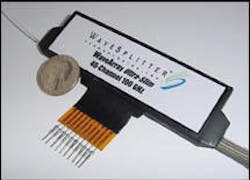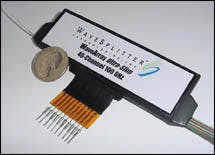Integration - Hybrid integration of planar lightguide circuit technologies
Monolithic integration is the long-term goal, but today, hybrid integration meets the system integrator's need for best performance.
BOB SHINE, JERRY BAUTISTA, KEVIN SULLIVAN, and BO ROTOLONI, WaveSplitter Technologies Inc.
Integrating multiple optical functions into a single device is widely viewed as a key step to lowering the cost of optical networks. Platform technologies such as planar lightguide circuits using silica-on-silicon or indium phosphide can greatly reduce the number of discrete elements and hence the associated labor, packaging, and testing costs of individual components. If automation is applied to these wafer-based processes, it can lower costs even further.
This trend toward optical-component integration is often compared to the evolution from discrete transistors to integrated circuits in the semiconductor industry. Two key challenges are quite different, however. First, in the photonics industry, different material systems are used to generate, modulate, multiplex, amplify, and detect the signal. Today, a component manufacturer must develop the manufacturing tools and processes as well as the product. While there is also a wide range of functions to be performed with semiconductors, silicon is the dominant material. This common platform allows equipment manufacturers to create a standard set of tools and processes. A second challenge arises from the complexity of interconnecting to singlemode fiber; these alignment tolerances differ vastly from wire bonding to semiconductor elements.
Unlike the semiconductor industry where the packaging is a small fraction of the product cost, packing represents a large portion of optical-component cost and remains a challenge for the photonics industry.
Integration to reduce cost can occur by increasing the number of channels or the number of functions in a device. An arrayed-waveguide grating (AWG) is one example of a single integrated device that is used to multiplex 40 or more channels. An integrated laser and modulator is an example of a single device in which multiple functions along a signal path are combined.
For a component manufacturer, integration across many channels is more straightforward because it can be done in a single material system. Although the initial installation cost of this approach is higher, if the cost per channel is significantly less than that of discrete elements, as is the case today for AWGs compared to discrete filters, it can offer significant benefits to system integrators.System integrators, on the other hand, value the integration of multiple functions along the signal path because this approach supports modularity as well as savings in size and cost. Using this approach, the benefits of integration can be realized even if the customer wants to buy a single channel at a time.
Integration also occurs by increasing the number of channels and the number of functions in a device. An example of this integration approach is a variable-optical-attenuator (VOA) multiplexer.
DWDM systems require elements to transmit, modulate, multiplex, amplify, switch, or detect the signals. The Table on page 27 lists the most commonly used materials to create these functions.* Integration of many channels always applies in DWDM systems, but some functionality occurs at remote locations so not all functions need to be integrated. While monolithic integration-integrating the multiple functions together using a single platform-is certainly a goal, there are likely to be a number of steps to reach that goal.
DWDM systems place stringent performance demands on the individual component such as the modulation speed for a modulator or the crosstalk performance of the multiplexer. These requirements increase with each generation of higher-speed and higher-channel-count DWDM systems. Because of these stringent and evolving requirements, individual device yields can be very challenging and the impact on overall yield must be considered for monolithic integration. With the wide range of functions required for a DWDM system, it is not surprising that no one technology platform can do it all well. Some work is being done with almost all the material systems listed in the Table to extend the functionality of each platform-this list is not absolute. During the development of these platforms, however, key performance criteria will be sacrificed.
To accommodate the system integrators' need for the best performance while integrating multiple functions along the signal path, hybrid integration-the integration of discrete elements based on multiple wafer-based platforms-appears to be the best approach. This type of integration includes both a module-level approach, where elements are interconnected with fiber arrays internal to the product as well as truly hybrid products where chip-to-chip interconnection occurs. Products based on this approach will likely include integration of both multiple channels and multiple functions to offer significant cost, size, and performance improvements.While hybrid integration may be required to meet the performance specification for the integrated product, even if the multiple functions can be performed in the same material system, improved manufacturability may result from integrating individual elements. Consider the yield impact of integrating three functions-an AWG, a switch matrix, and a VOA array-to create a reconfigurable add/drop multiplexer. Each of these functions can be performed using silica-on-silicon. But if these functions are integrated on a single wafer, then the cumulative yield is the product of the individual yields (assuming independent yield factors).
Let's assume a 70% yield for each function, a yield that many manufacturers of discrete elements would find acceptable. Since the entire device must be scrapped if any individual element fails, the combined yield of a monolithically integrated product is 70%*70%*70%=34%. Half of the devices are thrown away not because that element didn't meet specification, but because a neighboring device failed. Clearly, monolithic integration should only be done if the yield of each element is very high.
In contrast, hybrid integration allows individual components to be optimized. With a robust interconnection method, this approach should have minimal impact on overall yield. Moreover, individual components can be tested prior to integration. That simplifies the testing process because it is easier to understand the results of individual tests rather than de-convolve the test results of an integrated device.
With the benefits of hybrid integration established, it should be acknowledged that there are significant challenges to this approach. It is very difficult for a company to keep pace with the speed of technical innovation within a single platform, let alone establish excellence in the broad range of technologies required. Yet, if a component manufacturer focuses on a key element that is essential today, it may become the commodity of tomorrow. One potential outcome of these challenges is the integration not just of functions within a product, but also the integration of different suppliers' complementary technologies to create products. Although some may view these collaborations as a short-term reaction to the current economic climate, there are clear benefits to companies that can work together in this manner.
Hybrid integration adds a level of complexity to packaging. For this reason, most integrated packages today consist of integrated discrete modules. In this type of product, individual elements are integrated in a package but still use fiber array elements for the inte connection of the discrete elements. That allows the manufacturer to choose the best-of-breed technologies, resulting in a product with excellent overall performance. By providing the integrated product to customers, the manufacturer can also mon-itor cost trends and identify when a transition to a hybrid solution is required.
This approach is equivalent to the multichip modules in the semiconductor industry. The transition from module level to hybrid integration is difficult. It involves overcoming performance, reliability, and packaging challenges.
A key element of packaging is the chip-to-fiber connection. Waveguide components with a typical core dimension of 4 to 6 microns must be interconnected to singlemode fiber with an 8-micron core. Misalignment of more than 0.1 micron can result in significant attenuation loss. Fiber arrays allow rapid interconnection to high-channel-count devices. Since both the pitch of the fiber array and the waveguides are precisely defined, alignment is typically done by active alignment of the two end fibers-aligning the first fiber, then rotating the array around that fiber to align the last channel. In this way, a 40-fiber ribbon can be aligned with an identical labor content as a two-fiber array, greatly reducing the per-channel cost.
Both passive and active alignment can be used to attach the fiber array. In passive alignment, grooves are defined photolithographically to ac commodate the fibers. With active alignment, the process can be automated by monitoring the transmitted power in real-time to reduce the alignment time and improve yields. While both processes attempt to re duce the cost, a significant portion of the cost remains in the fiber array. Even if the piece parts snapped together, the cost is not significantly less.
Another challenge in packaging is to reduce the package size. While almost any integration will save space, the goal is to offer a high level of complexity in as small a package as possible. Straightforward integration results in a linear concatenation of functions, which can produce a larger box than desired. Often, the size of individual elements is limited by the waveguide properties of the material, specifically the refractive-index difference between the core and cladding.
Many companies promote one material system over another based on its size-reduction possibilities, which will allow more devices per wafer. However, a key benefit of the integration of smaller devices is the smaller size of the overall package. More devices per wafer can reduce piece part cost, but other piece parts dominate the cost. Different materials can offer reduced component size, but the product size may still depend on the size of the fiber array.
Finally, packaging requirements of one element may dictate the overall design and significantly affect the cost. If one element requires hermetic packaging due to reliability concerns, that will affect the cost of the integrated device. If the benefits of integration do not outweigh the cost of hermetic packaging for the integrated device, it doesn't make sense to integrate that element.
The integration path is likely to proceed from discrete modules to hybrid integration and finally to monolithic integration because of the immature state of fabrication tools.
Although monolithic integration is a long-term goal, hybrid integration meets the system integrator's need for the best performance, while combining multiple functions along the signal path. Packaging remains a challenge, but companies are developing robust, reliable, compact integrated modules to meet the cost targets of system integrators.
Dr. Bob Shine is director of marketing, Dr. Jerry Bautista is chief technology officer and senior vice president of technology, and Dr. Kevin Sullivan is vice president of engineering at WaveSplitter Technologies (Fremont, CA). Bo Rotoloni is director of planar lightguide circuits and modules at the WaveSplitter Atlanta facility.
* L. Eldada, "Advances in telecom and datacom optical components," Optical Engineering 40 (7), pp. 1165-1178 (July 2001).
Lightwave is a monthly international publication focusing on fiber optics and optoelectronics, the technologies driving the growth, convergence, and improved performance of telephony, computer communications, and video. Lightwave provides technology news as well as applications and product information for corporate and technical managers and staff engineers. Lightwave's editors emphasize analysis and interpretation in their reports on the technological impact of fiber-optic components, systems, and networks in these markets.


